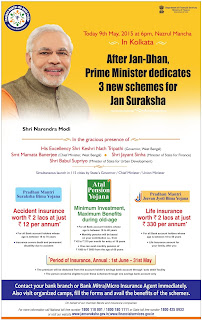I hope you would have heard
about the new social security schemes including two mass insurance schemes launched by our central government [Ref].
- Pradhan Mantri Suraksha Bima Yojana: Accident insurance
- Pradhan Mantri Jeevan Jyoti Yojana: Life insurance
- Atal Pension Yojana: Pension plan
I have
gone through the policy details and find that the insurance schemes are very good. I
suggest you can consider these policies and subscribe for both insurance
schemes, unless you are already sufficiently insured.
One major benefit is its simplicity. Premium will be auto-debited from the bank account, so it will continue forever (as long as you have sufficient balance).
Currently almost all banks are
providing subscription facility by sending SMS. These policies can be taken from
any bank but SMS details of all banks are different. SMS details for ICICI (to
be sent from registered mobile number) are as follows:
PMSBY NOMINEE NAME Y --> Send
to 5676766 (Accident insurance; premium Rs 12)
PMJJY NOMINEE NAME Y --> Send
to 5676766 (Life insurance; premium Rs 330)
I confirmed from the branch and they informed that since policy is effective from June 1st for those who send sms by May
31st, policy document will be ready in about 15 days after June 1st and we
shall be able to download it from ICICI Bank website, perhaps from insurance
tab.
If you heard PM Modi on TV speaking
from Bengal while launching it; the main attraction of this insurance policy is
that it can be taken by anyone, even by a person on deathbed or having a
terminal illness. This is how this policy is different! Mainly because it is
launched by govt.
I think claim process will be similar to the ones we have
for other insurance policies; we have to contact the insurance company.
Someone asked if it matters
which bank we take the policy from. From what I have read, this will indeed
make a different, as a customer friendly or unfriendly bank or its associated
general insurance company will behave with us like they behave with other
customers – customers of this scheme won’t be treated differently or
preferentially.
Someone asked if these polices
have any drawback. The only concern as it appears is that suppose there is a
Govt change at the center after 5 years and next govt discontinues it- then
what happens. But since both these schemes are kind of term insurance, i.e. you
get insurance until you keep paying premium, even if it covers us for 5 years;
what do we lose? We don’t lose anything but we are insured for the years it is
active in case of any eventuality. So I think we should definitely subscribe
since both are at very cheap rate of premium.
Also, while Atal Pension Yojna/plan
is only for unorganized sector; insurance schemes are for all. Because pension
and insurance are different. People in the organized sector already have either
PF or pension and hence don’t need Atal pension plan. But when it comes to
insurance, both organized and unorganized sector employees lack it – also
because regular insurance is costly; and hence govt launched these two
insurance schemes which are for all no matter in organized or unorganized
sector…
My recommendation is that we
should definitely take these policies (if we meet the eligibility).
Disclaimer: Views expressed are
personal.









